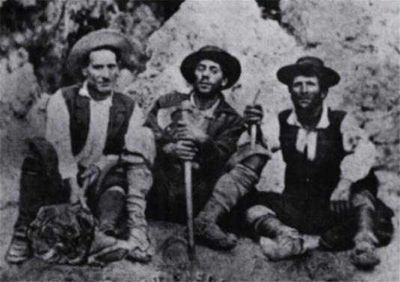“One is born a man, but later becomes a brigand,
until the last of our days we have to shoot,
and if we die, bring a flower for us,
in the name of the freedom for which we fought.”
Brigandage refers to the life and practice of Brigands: highway robbery and plunder. Brigandage is still a rather unknown and fascinating phenomenon. A new era of brigandage emerged in Southern Italy after the Unification in 1861. Social unrest, especially among the lower classes, occurred due to poor conditions and the fact that the Risorgimento (in Italian “Rising Again”) was said to only have benefited the higher classes in the Mezzogiorno (southern regions of Italy), or so the theory states. Poverty-stricken farmers who had fled due to extortionate Italian taxes placed on them and peasants who wanted land reforms took up arms against the common enemy – the newly formed Italian authorities and the land-owning upper classes. It is estimated that in 1862, only one year after the proclamation of the Kingdom of Italy, more than 350 bands of brigands were active in Italy. Amongst the brigands were a mixture of people: desperate peasants, farmers, people who the Italian government considered criminals, many former soldiers and loyalists of the Bourbon army, and also nobles. Many turned to brigandage in the mountains of Campania, Calabria, Abruzzo, and Molise to continue the fight against the northern invaders. Brigands had a particular “look” that gave them their unique appearance: they often wore a hat over long, unkempt hair, a bandana around their neck, a vest, and boots. Strapped around their waist or shoulder was always a rifle or another gun. Bands were led by brigands with legendary names like “Tranchella,” “Crocco,” “Caruso,” “Chiavone,” and “Mansi.” All of these so-called “legends” eventually found themselves forced into hard labor, imprisoned or executed by firing squad for their crimes. The unrest in southern Italy around 1861 was much more prevalent than in the other annexed states of northern and central Italy; mostly due to the fact that some form of brigandage had existed in the area since ancient times. In relation to the theory that regarded the brigandage in southern Italy as a revolt against the Unification, it is important to note that after brigandage ended (1865-1870) there was no anti-unification movement that followed. In fact, many southern Italians found themselves in high positions in the newly formed government. Some even claim that the word brigandage is a euphemism for civil war. Whether it was actually a political resistance movement or not, it is clear that brigands of that time caused much pain and suffering to the Mezzogiorno.
Il Brigantaggio
"Uomo si nasce, brigante si diventa,
ma fino all'ultimo dobbiamo spara'
e se moriamo, portateci un fiore,
pe' sta' libertà per cui abbiamo lottato ".
Il brigantaggio è una forma di banditismo che descrive generalmente una persona la cui attività è al di fuori della legge a scopo di rapina, estorsione, o che assume risvolti insurrezionalisti a sfondo politico e sociale. Una nuova era di brigantaggio – un fenomeno ancora per alcuni versi misterioso ed affascinante- emerse nel Sud d’Italia dopo l’Unificazione nel 1861, a seguito di una sollevazione contadina contro il potere economico e politico del nuovo Stato Italiano costituito. Le cause di questa rivolta furono la miseria ed le contine vessazioni che il popolo contadino doveva subire da parte dei più ricchi, insieme alle illusioni e alle aspettative fallite nel Mezzogirono da parte del Risorgimento che favorì solo le classi più agiate. Agricoltori scappati per sfuggire ad una tassazione insostenibile e contadini fautori di riforme demaniali si unirono per combattere il nemico comune: in nuovo governo centrale ed i ricchi proprietari terrieri. Si calcola che nel 1862, solo un anno più tardi dell’insediamento ufficiale del Regno d’Italia, fossero presenti sul territorio oltre 350 bande di briganti. I briganti potevano essere tutti: dal nobile, al contadino al bracciante. Questo fenomeno si diffuse nella parte del Sud Italia ed in particolar modo nelle regioni della Campania, della Calabria, dell’Abruzzo e del Molise. I briganti rispettavano un codice di abbigliamento che li rendeva unici. Portavano spesso i capelli lunghi e non curati con cappelli o fazzoletti intorno al collo. Indossavano il gilet con gli stivali. Ovviamente non mancava mai l’arma: un fucile o una rivoltella. Le bande erano comandate da capi dal nome leggendario come “Tranchella”, “Crocco”, “Caruso”, “Chiavone” e “Mansi”. La repressione da parte delle autorità contro questi personaggi “leggendari” fu durissima e tutti finirono con l’essere mandati ai lavori forzati, incarcerati o fucilati. Il brigantaggio postunitario - inteso come rivolta antisabauda e generalmente antiunitaria - interessò quasi esclusivamente i territori meridionali continentali ex-borbonici, mentre in pratica non si verificò nei territori di tutti gli altri stati preunitari italiani annessi al Regno di Sardegna per formare l'Italia unita durante il Risorgimento, in larga parte perché era esistito in quelle zone già in tempi antichi. In relazione alle teoria che il brigantaggio costituì una sommossa contro l’Unificazione, è importante evidenziare che una volta repressa tra il 1865 ed il 1870, non fu seguita da alcun movimento anti-unificazione. Al contrario, importanti incarichi nel neo-governo nazionale furono affidati ad esponenti politici del Sud. Alcuni sostengono persino che il termine brigantaggio sia un eufemismo per indicare una guerra civile. Sia che abbia rappresentato una forma di opposizione politica o meno, è indiscutible che i briganti dell’epoca abbiano causato dolore e sofferenza nel Mezzogiorno.



